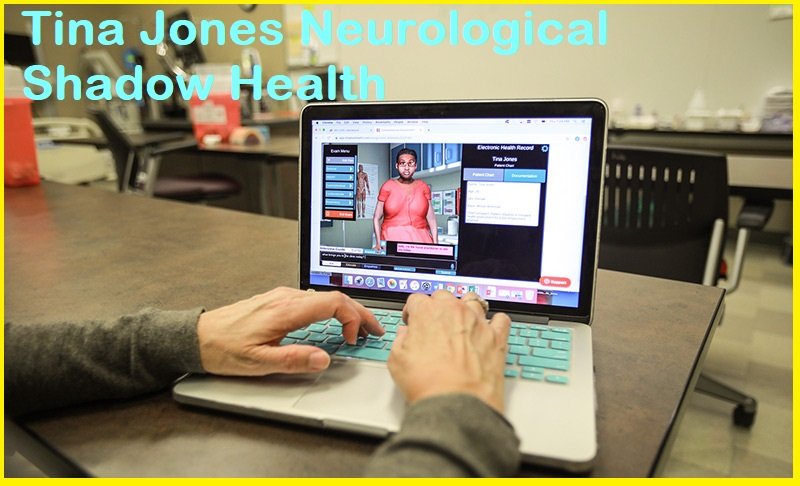Introduction to Tina Jones Neurological Shadow Health Assessment
The Tina Jones Neurological Shadow Health evaluation is a virtual simulation experience designed to help nursing students and healthcare trainees enhance their medical reasoning, evaluation, and documentation skills. It is a part of the wider Shadow Health Digital Clinical Experience (DCE) series that introduces college students to standardized sufferers through interactive, real-global scientific situations. Tina Jones, a virtual standardized affected man or woman, is a popular person utilized in a whole lot of Shadow Health assignments such as neurological, cardiovascular, breathing, and musculoskeletal checks.
The neurological exam especially checks a student’s functionality to perform neuro-targeted checks, understand unusual neurological signs and symptoms and symptoms, and file findings on the usage of appropriate clinical terminology. Understanding the way to conduct and interpret a neurological examination in a virtual environment like Shadow Health permits college students to bridge the distance among textbook learning and realistic scientific exposure.
This article will offer a whole manual to the Tina Jones Neurological Shadow Health undertaking, which include its motive, goals, anticipated findings, extraordinary practices, and common pitfalls. Whether you are becoming geared up for a nursing class or in search of to polish your evaluation skills, this deep dive will make sure you’re surely organized.
Purpose of the Tina Jones Neurological Shadow Health Assignment
The number one purpose of this simulation is to assist college university college students:
- Recognize neurological deficits and caution signs and symptoms and signs and symptoms of situations on the facet of stroke, neuropathy, or more than one sclerosis.
- Demonstrate information in cranial nerve assessments, motor skills assessment, and reflex checking out.
- Understand and perform the stairs of an entire neurological exam, which incorporates subjective and goal information collection.
- Build rapport and communique abilities with virtual sufferers thru sensitive and expert wondering.
- Improve the accuracy of medical documentation and the usage of the SOAP (Subjective, Objective, Assessment, Plan) layout.
Tina Jones, the affected character in the module, gives with several neurological signs and signs and signs and symptoms that require in-depth statistics of neuroanatomy, pathophysiology, and scientific judgment. The immersive nature of Shadow Health guarantees university college students are positioned in a realistic state of affairs in which every click on and question influences the affected person interplay.
Key Components of the Neurological Assessment in Shadow Health
Subjective Data Collection
The subjective phase consists of interviewing Tina Jones to gather her clinical statistics, present day signs and symptoms, and danger elements. Students need to be vigilant in the usage of open-ended questions to permit Tina to express her issues. Topics to cover encompass:
- History of Present Illness (HPI): Tina may additionally issue out tingling, dizziness, or headaches.
- Past Neurological History: Inquire about any seizures, migraines, or neurological accidents.
- Family History: Some conditions like epilepsy or stroke may additionally moreover run within the family.
- Lifestyle and Risk Factors: Alcohol use, drug facts, strain, and medicinal drug adherence all have an impact on neurological fitness.
Tip: Use empathetic language and lively listening to benefit entire subjective facts. Ask look-up questions like “Can you describe the feeling extra?” or “When did it begin?”
Objective Data Collection
The reason phase is where college students carry out the physical neurological examination. The Shadow Health platform lets in university college students to behave simulated checks by the usage of choosing frame components, clicking diagnostic gear, and receiving remarks. The essential additives of this evaluation encompass:
Mental Status Exam
Evaluate Tina’s:
- Orientation to character, vicinity, and time
- Memory recall
- Speech and language feature
Observation Tip: Tina ought to expose easy, coherent speech and an ability to conform with commands.
Cranial Nerve Assessment
Each of the 12 cranial nerves want to be tested, collectively with:
- CN II (Optic) – Visual acuity and peripheral vision
- CN III, IV, VI (Oculomotor, Trochlear, Abducens) – Eye movement and student reaction
- CN V (Trigeminal) – Facial sensation and chewing muscle tissue
- CN VII (Facial) – Smile symmetry and flavor
- CN VIII (Vestibulocochlear) – Hearing and stability
- CN IX & X (Glossopharyngeal & Vagus) – Swallowing and gag reflex
- CN XI & XII (Accessory & Hypoglossal) – Shoulder shrug and tongue motion
Motor and Sensory Function
- Muscle electricity and tone in pinnacle and decrease limbs
- Sensation trying out using tender and sharp stimuli
- Romberg take a look at, pronator waft, and heel-to-shin test for coordination
Reflex Testing
Assess deep tendon reflexes in the biceps, triceps, patella, and Achilles tendons.
Important: Ensure symmetrical reflex responses and grade them as it ought to be (0 to 4+).
Commonly Identified Issues inside the Tina Jones Neurological Exam
Students have to be aware of diffused symptoms and signs and signs and examine the logical go along with the drift of wondering. Some of the not unusual mistakes or overlooked findings encompass:
- Incomplete cranial nerve evaluation (frequently CN I or CN XI is skipped).
- Not performing coordination assessments similar to the finger-to-nostril or rapid alternating moves.
- Forgetting to invite protection troubles like falls, vision modifications, or balance troubles.
- Incorrect grading of reflexes or inadequate documentation in the SOAP phrase.
Pro Tip: Always use the comments and transcript function in Shadow Health to observe any unnoticed steps after your first attempt.
Sample Findings inside the Tina Jones Neurological Assessment
Here’s a favored evaluation of what college college students may in all likelihood look at during a nicely performed neurological exam:
- Mental recognition: Alert and oriented ×three; reminiscence intact.
- Cranial nerves: All cranial nerves intact, with everyday scholar reaction and facial symmetry.
- Motor feature: Equal power in all limbs (5/5).
- Sensory characteristic: Normal sensation within the path of; no paresthesia.
- Coordination: Smooth finger-to-nostril movement; Romberg terrible.
- Reflexes: Normal (2+) in all examined regions.
Students ought to phrase that Shadow Health scenarios range, so usually modify based totally mostly on Tina’s furnished signs and signs and symptoms and signs and symptoms and cues.
SOAP Note Example for Neurological Assessment
Here is an abbreviated instance of a SOAP observe that is probably submitted:
- S: Patient opinions occasional dizziness and slight numbness in right hands, lasting a couple of minutes, no contemporary head trauma.
- O: CNs II–XII intact. Sensation normal. Strength 5/five. Romberg is terrible. Reflexes 2+ bilaterally.
- A: No acute neurological deficits; signs and symptoms and signs and signs and signs and signs and symptoms may additionally suggest early carpal tunnel or vascular involvement.
- P: Recommend EMG and nerve conduction have a examine. Educate patients on ergonomic practices. Follow-up in 2 weeks.
Tips for Excelling in Tina Jones Neurological Shadow Health
To maximize your rating and analyzing revel in, preserve the ones strategies in mind:
- Always ask look-at-up questions for readability.
- Perform the complete neurological exam systematically.
- Keep an eye fixed on affected individual cues like facial expressions or hesitation.
- Use clinical terminology efficiently in your documentation.
- Review your Performance Score and Transcript put up-evaluation to choose out gaps.
Benefits of Shadow Health in Nursing Education
The Shadow Health DCE with Tina Jones gives a stable, immersive environment for college students to:
- Practice without risking real affected man or woman safety.
- Improve self assurance earlier than moving into clinical rotations.
- Learn medical reasoning, prioritization, and time management.
- Gain comments to sharpen clinical accuracy and empathy.
Especially within the post-COVID technology, digital simulations like this have become essential in changing or supplementing bedside clinicals.
Frequently Asked Questions (FAQ)
What is the Tina Jones Neurological Shadow Health assessment?
It is a virtual clinical simulation that allows nursing students to practice neurological examinations on a digital patient named Tina Jones.
How do I pass the Tina Jones Neurological exam in Shadow Health?
To pass, complete the full neuro exam, ask detailed questions, observe and record all findings, and ensure accurate SOAP documentation.
What are common mistakes in the Tina Jones Neurological simulation?
Skipping cranial nerves, forgetting reflex grading, and poor documentation are common errors that reduce scores.
Is Tina Jones a real person?
No, Tina Jones is a virtual standardized patient created by Shadow Health to simulate realistic patient interactions.
Can you retake the Tina Jones Neurological assessment?
Yes, you can retake it multiple times, and reviewing feedback and transcripts helps improve your performance.
Related Post : Duke Health Integrated Practice – Benefits, Structure, Care Model & More
Disclaimer
This article is intended for educational purposes only and does not substitute formal medical or nursing training. The information provided is based on publicly available educational modules and simulated content. Shadow Health is a proprietary platform, and all trademarks belong to their respective owners. For specific academic requirements or institutional guidelines, consult your professor or course materials.


